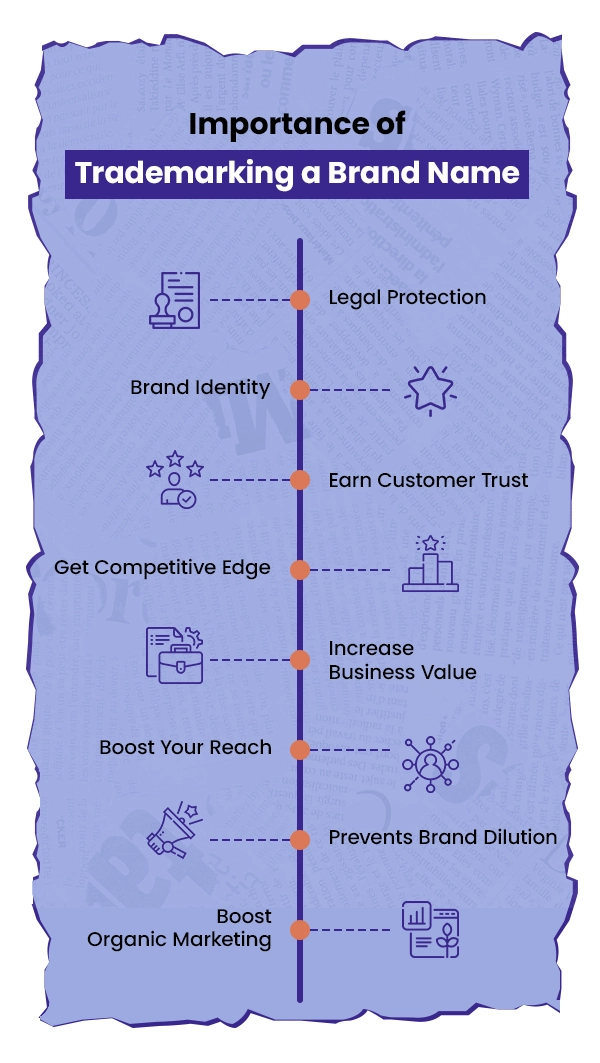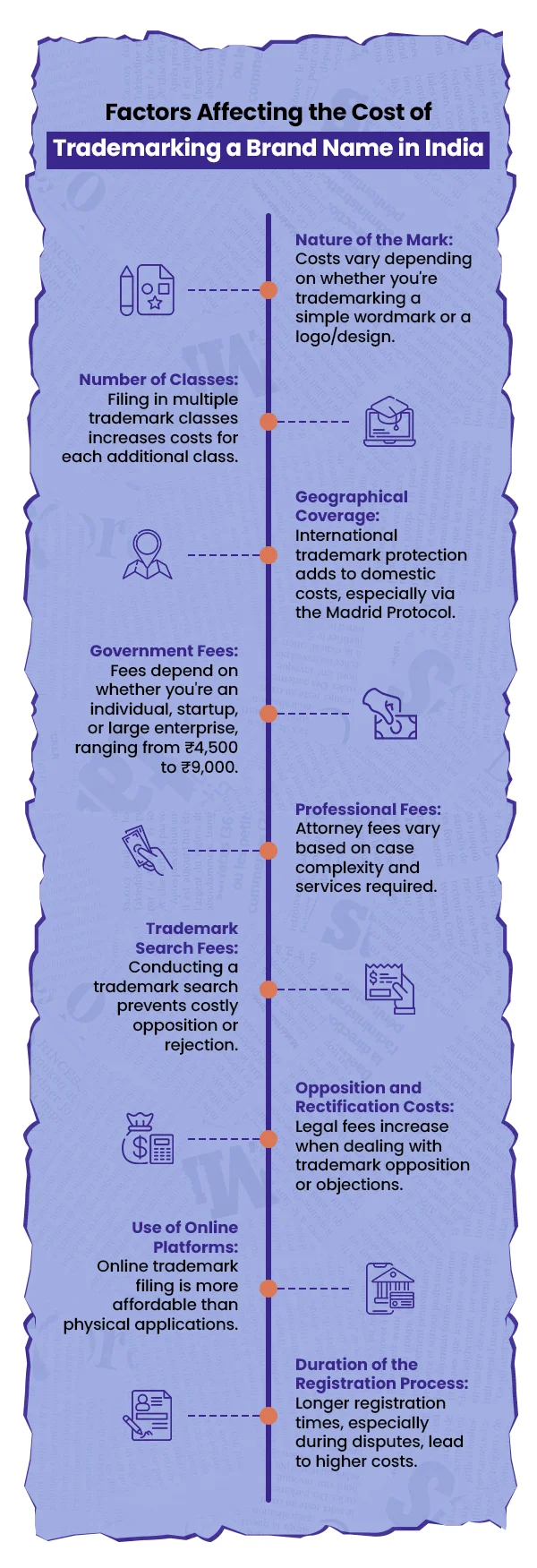| Getting your Trinity Audio player ready... |
What if someone else could legally use your brand name?
Scary thought, right?
Trademarking your brand isn’t just a formality—it’s the shield that protects your business’s identity.
Did you know that more than 50% of MSMEs lack trademark protection globally, with even higher numbers reported in India?
As your company grows, securing this protection becomes crucial. But in India, what does it actually cost to trademark your brand name?
Let’s explore the details and get your brand the protection it deserves!
What is a Trademark?
A trademark is a unique symbol, name, or logo that distinguishes your products or services from others in the market, playing a crucial role in effective business communication. It serves as a badge of identity, allowing consumers to recognize your brand easily.
Usually, trademarks include your brand logos, taglines, names, symbols, and even colors associated with a business with specific designs. For more
Also Read: Types of Brand Names To Inspire You For Next Big Idea
Importance of Trademarking a Brand Name
Let’s find out why securing a trademark is crucial for any business that wants to protect its brand identity and prevent unauthorized use!

- Legal Protection
- Trademarking your brand name gives you various legal rights such as taking action against people who misuse your name to misguide your customers or pretends as you.
- It stops others from using your name or making a similar one that could confuse customers. This protection helps guard your business against misuse or infringement.
- Brand Identity
- Your business or brand name is a key part of your business identity. By trademarking it, you can secure your brand’s image and keep it consistent, making your business recognizable.
- Earn Customer Trust
- A registered trademark assures customers that your brand is legitimate. This builds trust, which is important for customer loyalty and long-term relationships.
- Get Competitive Edge
- Trademarking your brand name gives you an advantage in the market. It stops competitors from copying your brand and helps you stand out, making consumers more likely to choose your trusted name.
- Increase Business Value
- A trademark is also a valuable business asset. As your brand grows, its value increases. A trademark can significantly increase its worth if you decide to sell or franchise your business.
- Boost Your Reach
- Trademarking in India can help you expand globally. Once you secure your trademark locally, you can use it to apply for protection in other countries, ensuring global recognition.
- Prevents Brand Dilution
- A trademark helps keep your brand strong and unique. It prevents others from using a similar name or logo, which could confuse customers and weaken your brand.
- Boost Organic Marketing
- Having a trademarked name strengthens your mouth marketing and increases organic reach. It also gives you the security to build your brand through ads and promotions without worrying about copycats or future legal battles.
Also Read: Licenses Needed to Start a Business in India
Costs of Trademarking a Brand Name in India
When trademarking your brand name in India, it is important to consider all the costs involved. These include government fees, professional fees, and possible extra costs during the process.
1. Government Fees
- For Individuals or Startups
Filing a trademark application costs ₹4,500 per class of goods or services. This lower rate encourages individuals, startups, and small businesses to protect their brands. - For Small Enterprises or Larger Businesses
For bigger companies, the government fee is ₹9,000 per application per class of goods or services. This fee is non-refundable, even if the application is rejected or opposed.
2. Professional Fees
- Trademark Attorneys
Businesses often hire trademark attorneys to handle the registration. Their fees range from ₹5,000 to ₹20,000, depending on the complexity of the case and the attorney’s experience. - Legal Assistance
If your application is challenged or opposed, legal help may be needed. These extra costs can vary, but having professional support helps avoid mistakes and ensures the process runs smoothly.
3. Additional Costs
- Trademark Search Fees
You should do a trademark search before filing to ensure your brand name is unique. Depending on the thoroughness of the search, the fees range from ₹1,000 to ₹5,000. - Opposition and Dispute Costs
If someone opposes your trademark or there are disputes, you may face extra legal fees starting from ₹10,000. These costs cover court or trademark office representation and can increase if the case is lengthy.
Knowing these costs upfront can help you better prepare for the financial side of trademarking your brand name in India.
Also Read: Brand Strategy vs Marketing Strategy – Know the Difference
Factors Affecting the Cost of Trademarking a Brand Name in India
Several factors can influence the overall cost of trademarking a brand name in India. Here’s a breakdown of the key elements determining how much you’ll need to invest.

1. Nature of the Mark
The type of trademark you are registering can impact costs. A simple wordmark (just the brand name) is generally easier and cheaper to trademark. However, additional searches and checks may be needed if your trademark includes a logo, design, or other elements, increasing government and professional fees.
2. Number of Classes
When filing for a trademark, you must specify the category (or class) under which your brand operates. India follows the Nice Classification system, which includes 45 classes of goods and services. Each class represents a different product or service category, such as clothing, technology, or food services.
If your brand name needs protection across multiple classes, the cost increases because you must file separate applications for each class. The government and professional fees apply for each class, potentially doubling or tripling your expenses.
3. Geographical Coverage
You must apply for international trademark protection if you want to protect your trademark beyond India. This can be done through the Madrid Protocol, which allows businesses to register their trademarks in multiple countries with a single application.
However, this significantly increases the cost as international fees are added to domestic government fees.
4. Government Fees
As discussed earlier, the cost of filing a trademark application differs based on whether you’re an individual, a startup, or a larger company. The standard government fee for startups and individuals is ₹4,500, while businesses or large enterprises must pay ₹9,000 per class. These fees directly affect your overall trademarking cost.
5. Professional Fees
Hiring a trademark attorney or legal expert is common to ensure the filing process goes smoothly. These fees can vary depending on the complexity of your case, the attorney’s experience, and the services you require. If your case involves disputes or opposition, professional fees will likely increase.
6. Trademark Search Fees
Performing a trademark search before filing is crucial to ensure your desired mark isn’t already in use. The cost of this search can range from ₹1,000 to ₹5,000, depending on how thorough the search is. Failing to do a proper search may result in opposition or rejection, increasing costs.
7. Opposition and Rectification Costs
Handling these can be expensive if your trademark application faces opposition or objections. The legal fees for dealing with opposition or rectification often range from ₹10,000 and up, depending on the complexity and duration of the case. This is an important factor to consider when budgeting for trademark registration.
8. Use of Online Platforms
Filing your trademark through the government’s online portal can save you money compared to physical filing methods. The Indian government offers a reduced fee for online applications. Professional services assisting with online trademark applications may offer more affordable rates.
9. Duration of the Registration Process
The longer the trademark registration process takes, the more costs you may incur, especially if legal assistance is required during disputes. While the standard process takes about 6-12 months, oppositions or objections can extend this period, leading to additional legal fees.
Understanding these factors can help you better estimate the total cost of trademarking your brand name in India. Proper planning and professional guidance can help manage these expenses and protect your brand efficiently.

Your search ends here!
What Documents Are Required for Trademark Registration?
When applying for trademark registration in India, you must submit certain key documents to ensure a smooth process.
Here’s a list of essential documents:
1. Trademark application form (TM-A) includes details about the trademark, applicant, and registered goods or services.
2. Proof of applicant’s identity, including documents like an Aadhaar, PAN card, or passport for individuals. If you apply as a business, you must submit an incorporation certificate or partnership deed.
3. Trademark Image or Logo: If your trademark includes a logo, provide a high-resolution image in JPEG format.
4. If you use a trademark attorney, submit signed documents (Form TM-48).
5. If you’ve already used the trademark, submit evidence like invoices, sales records, or promotional materials.
6. Businesses need to provide business registration or GST certificates.
Also Read: Types of Business Models Startups Should Know
The Trademark Registration Process in India
Below is the trademark registration process in India:
1. Trademark Research
Before filing a trademark, conduct a thorough trademark search. It is crucial because you can use this search to determine whether another company has registered or uses your chosen brand name, logo, or symbol.
The Trademark Registry’s online database can be used to do a trademark search to find any registered trademarks that may be contested with your application.
By doing this, you can lessen the likelihood that you will be rejected and help yourself avoid any possible legal issues.
2. Filing the Application
Next, you need to submit the trademark application after the research work is finished and you are certain the trademark you want is available. Form TM-A, the standard form for trademark registration in India, is used to apply.
It consists of:
- Information about the application (person or company)
- The actual trademark—wordmark, logo, or symbol
The class of goods or services for which the trademark will be registered (45 distinct classifications are used under India’s Nice Classification system for goods and services).
- Any necessary supporting documentation
- An explanation of the mark, if any
You can apply either online through the official website of the Controller General of Patents, Designs, and Trademarks or at the trademark registry office. Filing fees will vary depending on whether you are an individual, a startup, or a larger business entity.
3. Examination
After submitting the trademark application, the trademark office officially examines it. During this stage, the application is reviewed to ensure it complies with the legal requirements for trademark registration.
The examiner checks whether:
- The mark is unique and does not conflict with existing registered trademarks.
- The trademark meets the standards for registration under Indian trademark law.
- If no issues arise, the examiner accepts the application, and it moves forward.
However, if any issues are found, the examiner issues an Examination Report. The report may highlight objections related to similarity with existing marks, descriptive nature, or other legal grounds. You are given a certain time frame to respond to these objections and provide the necessary clarifications.
The application proceeds to the next stage if your response satisfies the objections.
4. Publication
After passing the examination phase, the trademark application is published in the Trademark Journal. This public announcement allows anyone with reservations about your trademark to voice them. Publishing allows any third party to challenge the trademark registration if it violates their rights.
The opposition period lasts four months from the date of publication. The trademark application moves forward for final registration if no opposition is filed within this period. If opposition is filed, the process enters a new stage of opposition proceedings.
5. Opposition (If Any)
The trademark enters opposition proceedings if someone files an opposition during the four-month publication period. The opponent and the applicant must present their arguments and evidence to support their case. The opposition may be based on various grounds, such as:
- The trademark is too similar to an already registered mark
- The mark is descriptive and not distinctive enough
- The mark being deceptive or likely to cause confusion
Both parties present their arguments before the Trademark Registrar, who will evaluate the case. If the opposition is resolved in favor of the applicant, the trademark proceeds to registration. If the opponent wins, the application is rejected or may need to be modified.
6. Registration
The trademark is registered if there is no opposition or the objection is reversed in the applicant’s favor. The Trademark Registry’s Registration Certificate certifies the mark’s official registration in India. Throughout the ten-year registration period, the trademark owner is the only one with the authority to use it for the goods or services specified in the application.
The trademark owner who registers it obtains legal protection and can take legal action against any unlawful use of the mark.
7. Renewal
In India, a trademark is good for ten years after registration. You have to renew the trademark before it expires to keep legal protection. By renewing it, you prevent the termination of your trademark and ensure that you maintain exclusive rights to it.
Your trademark has six months left until it expires to renew it. You have a six-month grace period after the expiration date, during which you can renew the trademark at an additional cost.
Also Read: Difference Between Target Audience and Target Market
Summing up
Trademarking a brand name in India involves various costs influenced by factors like the type of mark, classes, and professional fees. Understanding the process, required documents, and strategies to minimize expenses can help businesses secure their brand identity effectively and affordably, ensuring long-term protection and value.
Frequently Asked Questions
No, you don’t need a GST (Goods and Services Tax) registration or number to apply for a trademark. However, if you hire a lawyer or agency, their fees may sometimes include GST registration.
Yes, you can apply for a trademark using the Indian government’s online portal. However, hiring a professional can be helpful if you’re unsure about the process, as a small mistake can ruin your future business empire.
You can’t apply for a trademark if you don’t have legal ownership of the name or symbol. Trademarks that are offensive, generic, misleading, and already registered trademarks can’t be registered in India. You can check whether it’s possible to register on various online platforms, and please read government guidelines for registering a trademark before filling out the form.




